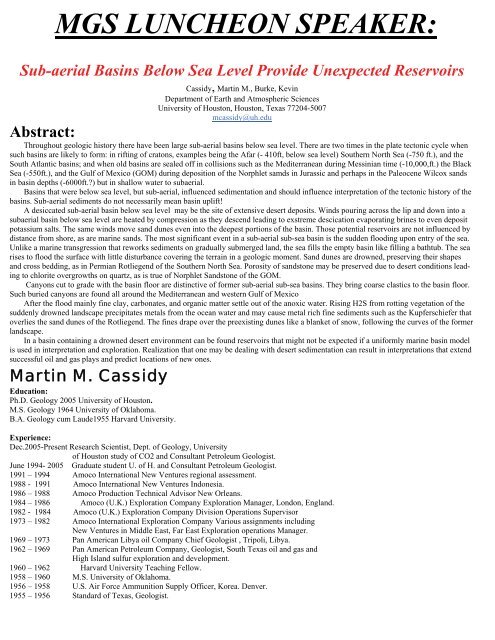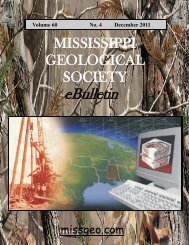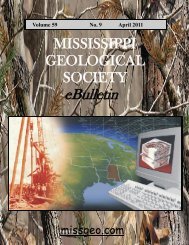March 2012 - Mississippi Geological Society
March 2012 - Mississippi Geological Society
March 2012 - Mississippi Geological Society
Create successful ePaper yourself
Turn your PDF publications into a flip-book with our unique Google optimized e-Paper software.
MGS LUNCHEON SPEAKER:<br />
Sub-aerial Basins Below Sea Level Provide Unexpected Reservoirs<br />
Cassidy, Martin M., Burke, Kevin<br />
Department of Earth and Atmospheric Sciences<br />
University of Houston, Houston, Texas 77204-5007<br />
mcassidy@uh.edu<br />
Abstract:<br />
Throughout geologic history there have been large sub-aerial basins below sea level. There are two times in the plate tectonic cycle when<br />
such basins are likely to form: in rifting of cratons, examples being the Afar (- 410ft, below sea level) Southern North Sea (-750 ft.), and the<br />
South Atlantic basins; and when old basins are sealed off in collisions such as the Mediterranean during Messinian time (-10,000,ft.) the Black<br />
Sea (-550ft.), and the Gulf of Mexico (GOM) during deposition of the Norphlet samds in Jurassic and perhaps in the Paleocene Wilcox sands<br />
in basin depths (-6000ft.?) but in shallow water to subaerial.<br />
Basins that were below sea level, but sub-aerial, influenced sedimentation and should influence interpretation of the tectonic history of the<br />
basins. Sub-aerial sediments do not necessarily mean basin uplift!<br />
A desiccated sub-aerial basin below sea level may be the site of extensive desert deposits. Winds pouring across the lip and down into a<br />
subaerial basin below sea level are heated by compression as they descend leading to exstreme descication evaporating brines to even deposit<br />
potassium salts. The same winds move sand dunes even into the deepest portions of the basin. Those potential reservoirs are not influenced by<br />
distance from shore, as are marine sands. The most significant event in a sub-aerial sub-sea basin is the sudden flooding upon entry of the sea.<br />
Unlike a marine transgression that reworks sediments on gradually submerged land, the sea fills the empty basin like filling a bathtub. The sea<br />
rises to flood the surface with little disturbance covering the terrain in a geologic moment. Sand dunes are drowned, preserving their shapes<br />
and cross bedding, as in Permian Rotliegend of the Southern North Sea. Porosity of sandstone may be preserved due to desert conditions leading<br />
to chlorite overgrowths on quartz, as is true of Norphlet Sandstone of the GOM.<br />
Canyons cut to grade with the basin floor are distinctive of former sub-aerial sub-sea basins. They bring coarse clastics to the basin floor.<br />
Such buried canyons are found all around the Mediterranean and western Gulf of Mexico<br />
After the flood mainly fine clay, carbonates, and organic matter settle out of the anoxic water. Rising H2S from rotting vegetation of the<br />
suddenly drowned landscape precipitates metals from the ocean water and may cause metal rich fine sediments such as the Kupferschiefer that<br />
overlies the sand dunes of the Rotliegend. The fines drape over the preexisting dunes like a blanket of snow, following the curves of the former<br />
landscape.<br />
In a basin containing a drowned desert environment can be found reservoirs that might not be expected if a uniformly marine basin model<br />
is used in interpretation and exploration. Realization that one may be dealing with desert sedimentation can result in interpretations that extend<br />
successful oil and gas plays and predict locations of new ones.<br />
Martin M. Cassidy<br />
Education:<br />
Ph.D. Geology 2005 University of Houston.<br />
M.S. Geology 1964 University of Oklahoma.<br />
B.A. Geology cum Laude1955 Harvard University.<br />
Experience:<br />
Dec.2005-Present Research Scientist, Dept. of Geology, University<br />
of Houston study of CO2 and Consultant Petroleum Geologist.<br />
June 1994- 2005 Graduate student U. of H. and Consultant Petroleum Geologist.<br />
1991 – 1994 Amoco International New Ventures regional assessment.<br />
1988 - 1991 Amoco International New Ventures Indonesia.<br />
1986 – 1988 Amoco Production Technical Advisor New Orleans.<br />
1984 – 1986 Amoco (U.K.) Exploration Company Exploration Manager, London, England.<br />
1982 - 1984 Amoco (U.K.) Exploration Company Division Operations Supervisor<br />
1973 – 1982 Amoco International Exploration Company Various assignments including<br />
New Ventures in Middle East, Far East Exploration operations Manager.<br />
1969 – 1973 Pan American Libya oil Company Chief Geologist , Tripoli, Libya.<br />
1962 – 1969 Pan American Petroleum Company, Geologist, South Texas oil and gas and<br />
High Island sulfur exploration and development.<br />
1960 – 1962 Harvard University Teaching Fellow.<br />
1958 – 1960 M.S. University of Oklahoma.<br />
1956 – 1958 U.S. Air Force Ammunition Supply Officer, Korea. Denver.<br />
1955 – 1956 Standard of Texas, Geologist.




